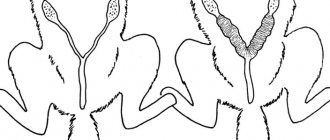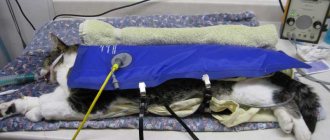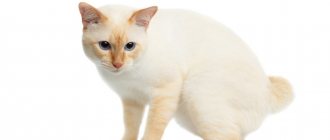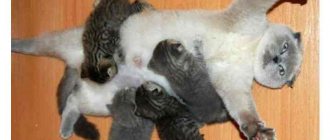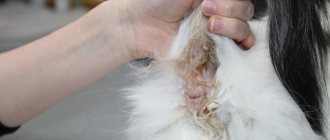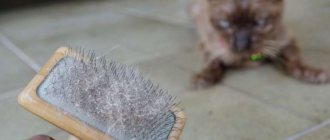Types of discharge
Purulent vaginal discharge in a cat can occur for various reasons. Therefore, they are diverse and there is even a classification of them. Most of this discharge is very dangerous for the cat’s health, so you should always be careful about this disease. However, there are also reasons that cannot lead to serious illnesses.
In order to understand how serious and dangerous a pet’s discharge is, it is necessary to collect the clots and determine their nature. But this can only be done by a specialist; such an analysis can be carried out in a veterinary clinic. And only after this can the cause of the disease be more accurately determined and how it should be treated.
There are two types of cat discharge: dangerous and safe. Any purulent discharge requires treatment and the attention of a specialist. You should not treat your cat yourself, as this can only cause harm and aggravate the progression of the disease.
Possible pathologies accompanied by discharge
Most often, any discharge from the genital organs indicates gynecological pathologies of the genital organs:
- Vaginitis is an inflammation of the vaginal mucosa.
The cat's discharge is yellow, yellow-white or mucopurulent. Almost always cloudy.
- Endometritis is an inflammation affecting the mucous and muscular walls of the uterus. In itself, it is not dangerous and can be successfully treated, but sometimes it can develop into a more dangerous pathology such as pyometra.
The cat experiences yellow-green or mucopurulent discharge, most often after 2-7 days from the birth of the kittens. Usually without a pronounced pungent odor
- Hydrometra - often develops against the background of endometritis, when fluid, mucus and exudate accumulate in the uterine cavity (up to 10 l).
When the form is open, the cat may have discharge that is yellow, whitish, and watery.
- Pyometra is a purulent inflammation of the uterus with accumulation of pus in its cavity.
There is no pure yellow discharge, there are gray-green, yellow-green, green and almost always with a foul odor.
- Hematometra is inflammation of the uterus with accumulation of bloody contents.
The discharge is usually red, red-green.
Discharge during pregnancy and childbirth
The owner should always be attentive to the cat during its pregnancy and especially during childbirth. Purulent discharge in a pregnant cat signals that something is going wrong in the body and the help of a specialist is needed.
It is known that during pregnancy and even during childbirth, clots form in cats, but they usually have either translucent shades or a greenish color. Their consistency is either similar to mucus, or it is a liquid of a certain color.
Physiological causes of discharge
Discharge appears after and during estrus, after pregnancy, and also in the first few days after sterilization. If the nature and color of the discharge corresponds to the physiological period, then there is no reason to worry. However, it is recommended that the assessment be carried out by a specialist.
- During sexual heat, the discharge changes its color, depending on the period of the cycle: a pink-red hue turns into transparent mucus. After estrus, yellow discharge that lasts more than 2-3 days is already a reason to take the cat to the veterinarian. The symptom may be a sign of some gynecological disease.
- In a pregnant cat, yellow discharge cannot be normal. During a normal pregnancy, the cervix is closed and there can be no discharge.
- The end of labor may also be accompanied by a certain amount of reddish discharge, turning yellowish. Within a week after giving birth, there is no cause for concern if the cat’s general condition does not deteriorate. 1-3 days before birth, yellowish discharge may indicate that the body is preparing for the process of giving birth to kittens. The receding mucous plug usually looks the same color, but in most cases the cat immediately licks the perineum and the owners do not notice anything at all.
- A sterilized cat may have a certain amount of yellowish-mucous discharge in the first few days after surgery, but without any foreign odor and in the normal general condition of the animal. If a lot of time has passed after the operation, and discharge appears or does not stop, then the most common causes are cultitis (inflammation of the stump at the site of removal of the uterus), stump cyst or inflammation of the uterus, when not complete sterilization was performed, but only oophorectomy (the ovaries were removed, but the uterus was removed). left).
Causes of dangerous discharge
Dangerous purulent discharge in a cat always requires treatment and careful attention. There are several reasons for their occurrence. First of all, these are any types of infections, as well as various inflammations, cancer and other equally serious causes.
A pregnant cat always requires special attention, as complications may arise during childbirth, in which case part of the placenta remains inside the animal. Most often, purulent vaginal discharge in a cat indicates that the process of decomposition has begun in its body. To cure a sick animal, surgery is necessary.
Another reason may be an infectious disease of the genitals. If a cat has purulent discharge with a reddish tint, then most often this indicates that pathogenic processes are occurring in the animal’s uterus or in its bladder. They are easy to distinguish, since then such secretions do not have any odor, but are characterized by a peculiar and thick consistency. As soon as such signs appear in a cat, you should immediately contact a veterinarian.
Purulent discharge from a cat's loop, the treatment of which requires special attention, can also occur with cancer.
You should always pay attention to the smell of the discharge. Thus, a cat’s purulent discharge from the loop (vagina) has a peculiar smell, which will indicate that destructive processes are taking place in the cat’s body.
The cause of discharge with pus can also be inflammatory processes of the mucous membranes. You should carefully monitor your cat's behavior, as at this time she becomes restless and even aggressive. Can lick itself often and for a long time. Such a cat will be reluctant to go to the toilet, so it will show aggression and behave anxiously. This is due to the fact that she experiences pain when urinating.
If there was an injury to the bladder or uterus, then the cat may also have purulent discharge. Any injury to an animal will be accompanied by discharge, so the owner must provide it with immediate medical attention.
Vaginal discharge in cats: symptoms, treatment, herbs
Vaginal discharge
Vaginal discharge, especially in unsterilized (non-castrated) cats, can be a sign of a wide variety of diseases.
Purulent vaginal discharge is one of the symptoms of pyometra.
Pyometra is a serious disease, in many cases immediately life-threatening for cats. This is why you should never try to treat pyometra yourself at home. When pyometra develops, veterinarians most often perform surgical removal of the ovaries along with the uterus; The operation is performed against a background of intensive therapy and antibiotics.
If you notice vaginal discharge in your cat, first assess the severity of your pet's condition by answering the following questions:
♦ Has your cat been sterilized?
♦ When was the last time you noticed signs of estrus (heat)?
♦ Does your cat seem lethargic?
♦ What color are her gums?
♦ How quickly does the color of the gums return after the pressure stops - immediately or after 2-3 seconds?
♦ Does your cat have excessive thirst or polyuria (increased urine production)?
♦ Is there any irritation of the skin around the vulva due to discharge?
Vaginal discharge. You need EMERGENCY help from a veterinarian if:
♦ You suspect the development of pyometra (main symptoms: signs of intoxication, discoloration of the gums, vaginal discharge or its absence, polyuria, lethargy, increased thirst)
♦ The cat develops lethargy, regardless of the presence or absence of other symptoms.
Vaginal discharge. Do not delay visiting a veterinary hospital for too long:
♦ If the cat’s vaginal discharge does not become clear within 1–2 weeks.
♦ If vaginal discharge irritates the skin (the cat constantly licks the genital area).
Vaginal discharge. Treatment
To enhance resistance to infection, it is advisable to administer vitamin C at a dose of 5-10 mg/lb of body weight 2-3 times a day. (note: 1 lb = 373.2 g). To strengthen the immune system, it is also advisable to prescribe herbal medicines such as:
♦ Canadian goldenseal;
♦ astragalus;
♦ cat's claw;
♦ Echinacea.
The above medicinal plants can be used either individually or in combination.
How to prepare an infusion.
♦ Pour one teaspoon of dry raw material into a glass of boiling water, leave until completely cooled and strain. Give the infusion to your cat 2-3 times a day, 1/4 teaspoon per 10-20 pounds of animal weight.
Goldenseal infusion is a fairly strong herbal medicine, so you SHOULD NOT use it for more than 7 days.
If you are unable to find the above medicinal plants, you can use pharmacy tinctures. Dose 5-10 drops per 10-20 lbs of animal weight. Give the tincture, just like the infusion, 2-3 times a day.
TIP: Before using the alcohol tincture, pour the required number of drops into a spoon and leave for a while - let the alcohol evaporate. This is especially important when using alcohol tinctures to treat cats.
Nettle infusion helps increase the resistance of the genitourinary system to infection.
To irrigate the area of inflammation, you can use a local infusion of herbs or pharmacy tinctures of Hypericum (St. John's wort) or Calendula (Calendula). The infusion is prepared according to the method described above. If you use a tincture for irrigation, then dilute 10–20 drops of the tincture in one glass of boiled water.
In addition to herbs, irrigation can be carried out with diluted vinegar: dilute 1–2 tablespoons of 7% table vinegar in a glass of water.
How to perform vaginal irrigation in cats.
Vaginal irrigation is carried out using a Janet syringe, which is carefully inserted into the vagina to a depth of a quarter or half an inch. If you have a small breed cat, you can use a plastic syringe without a needle or an ordinary pipette.
Health to you and your pets.
Source: “Homeopathic treatment of cats and dogs.” Don Hamilton.
Cats are very clean animals. Any discharge from natural anatomical openings should alert the owner and prompt him to seek advice from a veterinarian so as not to miss serious pathologies. Not all uterine discharge is dangerous, but you need to pay attention to its color and consistency. Yellow or yellow-green discharge in a cat almost always indicates a dysfunction of the reproductive system.
Endometritis
Purulent discharge from the uterus in a cat should always alert the owner. Sometimes the cause of such processes in the animal’s body is endometritis, which can manifest itself in two forms. The first form is chronic, in which it is usually impossible to detect the disease in a timely manner, since the cat behaves quite normally.
The acute form of this disease negatively affects the condition of the animal; it does not show any interest in the surrounding world. With this disease, a four-legged friend not only shows apathy, but also lacks appetite. If you do not consult a doctor with this form of the disease, the cat may die.
Unhealthy uterine discharge
Inflammatory diseases of the uterus lead to the accumulation of pathological substances in its cavity - waste products of bacteria, ichor, particles of epithelium, etc. Blood or pus from the vaginal opening may be a symptom of urogenital tract cancer. A cat suffers from discharge due to the following dangerous diseases:
- vaginitis;
- pyometra;
- hematometers;
- hydrometers;
- endometritis.
This is an inflammatory process in the vagina, which can be acute or chronic. Ulcers form on the surface of the mucous membrane, and the cat is bothered by discharge:
- cloudy or transparent;
- viscous yellow-white;
- mucous membranes are purulent.
Mild forms of the disease are treated with douching; in severe cases, systemic antibiotics are indicated.
© shutterstock
Life-threatening inflammation of the uterus, requiring urgent medical attention and surgical intervention. If a cat frequently licks itself, and brown wet spots remain everywhere on the bedding and carpets, then such symptoms should alert the owner. There are also other warning signs:
- tight or bloated belly;
- increased body temperature;
- lack of appetite, but strong thirst;
- frequent urination;
- decreased physical activity of the pet, lethargy.
In some cases, the cat's purulent discharge increases in quantity so quickly that the symptoms of the disease simply do not have time to appear. The walls of the uterus cannot withstand the load and rupture, and the contents spill into the abdominal cavity. Naturally, it is no longer possible to save the pet’s life.
Hematometer
The condition is characterized by the accumulation of blood in the uterine cavity, disrupting the functioning of the organ. Often blood cannot escape due to blockage or narrowing of the cervical canal, so the discharge from the cat's uterus is very scanty. The reason may be:
- congenital anomalies;
- muscle spasm of the cervical canal;
- surgical procedures performed incorrectly;
- miscarriage or abortion;
- pathological births (especially if they happen more than 1-2 times a year);
- uterine fibroids.
Blood is a rich nutrient medium for the proliferation of harmful microorganisms, which is why sooner or later inflammation of the uterus begins.
The cat has a fever and cramping pain appears. When helping an animal, clots must be scraped out of the uterine cavity and antibacterial therapy is prescribed. If hematometra is not diagnosed in time, purulent contents form in the uterus and the disease is complicated by pyometra. Fortunately, this disease is quite rare.
In a cat, discharge from the uterus may be a symptom of inflammation of the walls or mucous membranes of the organ. Acute endometritis occurs more often after childbirth due to delayed release of the placenta, infection of the vagina and cervix.
Mucopurulent discharge appears in cats from the genital slit 2–6 days after the birth of kittens.
Urination becomes more frequent, milk production decreases, and the temperature rises. The animal arches its back and meows pitifully due to pain in the uterus. In the absence of therapy, the pathology becomes chronic. The infection spreads to the muscular and outer layers of the uterus and penetrates the blood. As a result, the pet dies due to sepsis. Blockage of the cervical canal threatens the development of pyometra.
© shutterstock
Hydrometer
Fluid accumulates in the uterine cavity - gland secretion, mucus, transudate in quantities of up to 10 liters. If the excretory channel is open or partially blocked, then the cat experiences white or transparent discharge. Usually they are scanty, smearable or drop-shaped. The disease often develops against the background of chronic endometritis, as a result of which the uterine walls become thinner and stretched, and adhesions and scars form. Without timely treatment, the cat dies.
The cat has purulent discharge in Rostov
Pyometra
One of the causes of the disease in cats can be pyometra. Most often, it manifests itself in the fact that mucous and purulent discharge comes from the cat’s vagina. They can be of different colors: brown, white or red. When the disease occurs in an open form, the main symptom is the expansion of the genital organs.
If this disease develops into a more complex form, then there will be no more clots. This is due to the fact that all the purulent masses gradually accumulate in the cat’s body and negatively affect its body and the functioning of individual organs. If you consult a doctor at an early stage of the disease, then there is a chance to save the cat. At a late stage of the disease, the animal’s uterus is already closed, intoxication occurs in the body, and there is practically no chance of salvation. Most often, late stages of the disease lead to the death of the animal.
What is considered a physiological norm?
It is completely natural for a cat to have discharge during heat or estrus. The color of the discharge during this period is transparent, and the consistency is uniform without an unpleasant odor. The heat does not stop for several days, and the cat arches her back, exposes her hindquarters, and shows excessive playfulness and affection.
© shutterstock
Pregnancy and childbirth
Discharge during pregnancy may appear in a cat up to the third week. This is due to the fact that a mucus plug forms in the cervix, the excess of which flows out . This is usually clear or stringy mucus that is difficult to notice because it comes out along with urine. Until the 6th week, yellowish discharge is very rarely observed in small quantities - excess amniotic fluid.
And only a day or two before birth does the mucous plug come off (at 9 weeks). This is a small clot of yellow or greenish tint.
During contractions and pushing in a cat, the presence of brown and bloody discharge from the uterus is normal. For some time after childbirth, liquid greenish discharge appears, gradually becoming lighter, and then completely disappearing.
Scarlet blood at any stage of a cat’s pregnancy is always a sign of pathology and can be a signal of uterine rupture. The reason for the release of brown clots is placental abruption or fetal death . Green ones with an unpleasant odor indicate a bacterial infection, most likely due to the death of the kitten and the beginning of the decomposition process.
Treatment of purulent discharge
Purulent discharge in a cat is a reason to consult a doctor. In addition, alarming symptoms include:
- the cat constantly tries to lick the crotch;
- abdominal consolidation;
- poor appetite;
- complete indifference of the animal to what is happening around.
The veterinarian will definitely perform a thorough examination of the cat, and he will also take a smear from the purulent lesion for examination. To make a diagnosis, the animal will undergo all the necessary procedures: ultrasound, tests.
For each type of disease, its own treatment is prescribed, which can only be determined by a specialist. The easiest way to treat purulent discharge in a cat is to take antibiotics. If the discharge is too active, then only a doctor can decide on surgical intervention. This is required if it is necessary to remove infected organs. You should not treat your cat with folk remedies, as this can only worsen the course of the disease and even lead to the death of the animal.
Treatment of pyometra
With closed-type pyometra, surgery is always performed to remove the uterus and ovaries. Drug treatment is resorted to only when it is necessary to preserve the reproductive function of the animal’s body. Therapy is carried out with hormonal drugs and antibiotics. The treatment is quite long. It is carried out in courses. If after pyometra the cat has a leak from the loop, then the therapy has not brought results and the pet is sent for surgery.
Drug treatment most often ends in relapses, so it is not recommended and surgery is often performed to remove the uterus and ovaries. If left untreated, open pyometra in a cat can lead to serious complications and death. Lack of timely assistance with closed pyometra leads to uterine rupture and painful death. It is for this reason that if symptoms of the disease appear, you should not hesitate to visit the veterinarian.
Treatment of uterine inflammation in a cat
It is known that the most common reason for purulent discharge from an animal’s vagina is vaginitis. It is not difficult to identify such a disease if you carefully monitor your cat’s actions. For example, she will lick herself under her tail often and for a long time.
One of the causes of the disease in cats can be pyometra. Most often, it manifests itself in the fact that mucous and purulent discharge comes from the cat’s vagina. They can be of different colors: brown, white or red. When the disease occurs in an open form, the main symptom is the expansion of the genital organs.
If this disease develops into a more complex form, then there will be no more clots. This is due to the fact that all the purulent masses gradually accumulate in the cat’s body and negatively affect its body and the functioning of individual organs. If you consult a doctor at an early stage of the disease, then there is a chance to save the cat.
Purulent discharge in a cat is a reason to consult a doctor. In addition, alarming symptoms include:
- the cat constantly tries to lick the crotch;
- abdominal consolidation;
- poor appetite;
- complete indifference of the animal to what is happening around.
The veterinarian will definitely perform a thorough examination of the cat, and he will also take a smear from the purulent lesion for examination. To make a diagnosis, the animal will undergo all the necessary procedures: ultrasound, tests.
For each type of disease, its own treatment is prescribed, which can only be determined by a specialist. The easiest way to treat purulent discharge in a cat is to take antibiotics. If the discharge is too active, then only a doctor can decide on surgical intervention. This is required if it is necessary to remove infected organs. You should not treat your cat with folk remedies, as this can only worsen the course of the disease and even lead to the death of the animal.
– neoplasia of the urogenital tract;
– unhealthy position of the ureter;
– trauma to the vagina or the presence of a foreign body in it;
– urogenital infections;
– pyometra and others.
Treatment of various discharges in a cat occurs by prescribing antibiotics, chemotherapy, and restorative therapy. In many cases, surgery is required to remove the tumor or correct organ defects. In any case, the sooner you bring your pet to our clinic, the sooner the veterinarian will be able to conduct the necessary additional examinations and prescribe a course of effective treatment.
Purulent discharge in a cat is significantly different from the rest. Often they indicate unusual and pathogenic processes in the body, which can lead to disastrous results.
Therefore, if any formations of this type are detected, you should immediately take the cat to a veterinary clinic. Only there will the doctor be able to check the nature of the purulent formations and draw conclusions that will help avoid negative consequences.
Purulent vaginal discharge is very diverse, so there may be several reasons. Most of them are an immediate danger to the cat's health. However, there are also more passive prerequisites that can be taken more calmly.
Healthy cats are full of activity and appear cheerful. Any disease, even a minor one, always affects the behavior of the animal. An attentive owner will definitely notice alarming symptoms and seek medical help from a veterinary clinic.
A cat can get sick at any age. And also the development of pathologies does not depend on the breed of the animal. If your cat’s health deteriorates, the following general signs may be observed:
- lethargy of the animal;
- poor appetite;
- anxiety;
- sleep disturbance.
If a cat refuses a favorite treat, this should alert the owner
Diseases in cats can be divided into the following types:
- parasitic. The most common parasites that affect cats are: fleas - wingless insects 2–2.5 mm in size. Once on the skin, the flea bites the cat and begins to feed on the animal’s blood. If fleas are detected, treatment can be carried out independently, however, contacting a veterinarian will not be superfluous. A specialist will select effective and safe medications for the animal: special shampoos and sprays, drops on the withers;
The flea has many legs, thanks to which it is securely attached to the cat's skin.
We suggest you read: Clotrimazole for cats
Stray cats and dogs are often carriers of the rabies virus
The cause of dermatitis in a cat may be an allergic reaction to the shampoo used.
If heart pathology is suspected, the cat is examined using an electrocardiogram
Treatment of conjunctivitis is carried out by instilling antimicrobial drops into the eyes.
Exposing a cat to cold for a long time can lead to otitis media.
Uterine torsion is a common pathology in pregnant cats.
The health of a pet is the key to its full, happy life and the joy of its owners. Much depends on the correct conditions of detention, feeding and amount of attention. Understanding the physiology and characteristics of cat development are also important building blocks in ensuring the well-being and longevity of the animal.
Pyometra disease in cats, symptoms and treatment of which are the objectives of research by veterinarians around the world, can seriously threaten a cat's life. Studying the symptoms and treatment methods will help prevent a sad outcome and maintain the health of the animal.
A fairly frequently diagnosed disease, pyometra, is more often detected in older females, but cases of malaise in young and middle-aged individuals are not uncommon.
The following prerequisites for its development are identified:
- Favorable conditions for the development of bacteria in the uterine cavity in the first 2-3 months after estrus. Increased levels of progesterone stimulate and, accordingly, thicken the uterine mucosa. If pregnancy does not occur, it enlarges and cysts form that secrete fluid - ideal conditions for bacterial development. The same excess hormone does not allow the walls of the uterus to push out what has accumulated. At the same time, the leukocytes protecting the cavity do not work: nature’s concern is for the sperm, which can be destroyed by them. As a result, infection occurs.
- Uncontrolled use of hormonal drugs that stop or reduce estrus. This measure often causes changes in the uterus that are suitable for this physiological process. Estrogen, natural or synthetic, enhances the action of progesterone, which can trigger the development of inflammation.
Additional risk factors include violation of hygiene standards during a cat's heat, possible unsanitary conditions during childbirth, uncontrolled mating, impaired immune processes, congenital hormonal changes, and low physical activity. Cats that have not given birth, as well as those that gave birth prematurely or had pathologies, have the greatest predisposition to the disease. The only way to completely protect an animal is by sterilization and removal of the uterus and ovaries.
In the initial stages of pyometra, the cat may not show any concern. The general condition does not worsen; it is possible to drink more water, which, as a rule, goes unnoticed.
The animal becomes anxious, its appetite worsens, and its temperature rises. A clean cat itches until it hurts and loses hair, a symptom that is rarely associated with the accumulation of pus in the body, but rather with the presence of parasites or skin diseases. This is why primary signs often do not attract attention, which can lead to serious consequences.
It is worth paying attention to:
- enlarged abdomen;
- constant thirst with frequent urination;
- brown or white discharge, often cloudy with an unpleasant odor;
- angry restless behavior;
- frequent licking of the abdominal area;
- loss of appetite and excessive vomiting and diarrhea;
- dullness and ruffled coat.
These signs may appear partially or be absent altogether. If the cervix is closed, the pus quickly accumulating inside poisons the body through the bloodstream, and the uterine wall with all its contents may rupture into the abdominal cavity. This situation directly threatens the life of the cat.
An urgent visit to a specialist is the only chance to save your pet. If your cat has bleeding after giving birth or it appears suddenly, you should immediately get a diagnosis at a veterinary clinic.
Doctors will be able to confirm or refute the animal’s diagnosis after:
- palpation;
- a blood test that checks the concentration of leukocytes and globulin, urine for specific gravity (underestimated will show the effect of toxins on the kidneys as a result of a bacterial infection);
- X-ray (in this case, with an open cervix, it may not give results due to the gradual self-excretion of pus);
- an urgent ultrasound of the cat, which is considered the most informative method (it will exclude a possible pregnancy, its consequences, and will make it possible to see even minimal enlargement of the pelvic organs).
Even if a cat meows restlessly after giving birth, it is better to play it safe and thereby avoid the death of the animal. If you have any suspicion, it is better to visit a doctor without expecting dire consequences!
No matter how endometritis progresses in cats, the symptoms and treatment should be confirmed and carried out by a doctor. Complete recovery of the pet is possible only after surgery: removal of the uterus and ovaries.
What kind of discharge in cats is considered unhealthy?
Suspicions of a pathological process are caused by vaginal discharge of the following type and consistency:
- White, if they are not associated with pregnancy or childbirth, then indicate vaginitis or pyometra. An additional pathological symptom is an unpleasant odor.
- Yellow-colored or bloody, foul-smelling, occur with postpartum endometritis or miscarriage.
Purulent discharge
The inflammatory process begins with the release of liquid transparent mucus, which gradually thickens, becomes opaque, first white, then acquires a creamy, yellowish, greenish or brown color. Darkening of the exudate is a sign indicating the death of mucosal tissue.
Your cat is bleeding: what to do?
When blood flows from the vagina in drops, clots, or along with exudate, it means that the cat has developed hematometra - a life-threatening illness.
The symptom indicates a violation of the integrity of blood vessels. In this case, urgent veterinary assistance is required.
Treatment of uterine inflammation in a cat
A problem such as inflammation of the uterus in a cat cannot be ignored.
A loving owner, if a change in the pet’s condition is detected, will always immediately show it to a specialist for timely detection of the disease and treatment. If treatment is not carried out on time and the animal is left without help, the disease will progress and ultimately lead to death. The presence of uterine inflammation in cats is possible only if the animal has not been sterilized. After surgery, the uterus of a cat, like a sterilized dog, is removed.
In veterinary medicine, purulent inflammation of the uterus in a cat is called pyometra. With this pathology, pus accumulates in the organ cavity, causing the inflamed uterus to dangerously enlarge. The pathology can affect not only the animal that gave birth. A young cat that has never been pregnant can also experience such inflammation. This feature made it possible to determine that bacteria are not the main provocateurs of the disease.
Today, veterinarians have found that the disease is provoked mainly by the following reasons:
- hormonal imbalances, after which endometritis was not fully treated;
- inflammatory pathologies of the urinary system that have not been properly and completely treated;
- giving the animal hormonal drugs to prevent estrus and pregnancy;
- violation of sanitary rules at the time of mating of an animal, when a cat and a cat are brought together that has not been examined for various bacterial infections of the reproductive system;
- unsanitary conditions in the place for childbirth, due to which dirt and pathogenic bacteria are introduced into the birth canal and uterine cavity;
- the remains of the placenta that did not come out after the birth of the kittens - suppuration in such a situation develops within a few days after lambing;
- pathologies in the structure of the reproductive system, in which an open cervix provides bacteria with free access to the inside of the organ.
Stress, during which an animal experiences a sharp general decrease in immunity, deserves special attention. If lambing occurs during this period, or the cat is in a state of heat, then the uterus is defenseless against pathogens, which rapidly develop against the background of hormonal changes in the body.
The disease has 3 forms. The greatest danger of them is the hidden one, due to which the animal’s condition deteriorates very slowly, and symptoms appear only at the last moment, when the uterus is close to rupture, and it is almost impossible to help the pet.
Another form of inflammation, in which the cat’s uterus has an open cervix, is not so dangerous, since it cannot lead to the death of the animal in 1-2 days. However, this does not mean that the cat can do without therapy. If the animal's condition is left unattended, its death will occur within 1-2 weeks. Only sometimes there are cases when a very strong cat can live up to 3 weeks. With this pathology, the animal experiences the following symptoms of uterine inflammation:
- discharge of pus from the genital fissure (vagina);
- the cat licks the external genital area excessively;
- dark brownish spots where the cat sleeps;
- complete loss of appetite;
- elevated temperature;
- The cat drinks a large amount of liquid.
Every day the pet's condition worsens. The volume of purulent discharge increases, the uterus constantly pours out pus, and the cat no longer has time to wash it off, which makes it noticeable not only on the bedding, but also on the fur around the genital opening.
Usually the disease begins to manifest itself 1-2 months after inflammation begins to develop. During this time, bacteria manage to multiply in sufficient quantities in the uterine cavity, where favorable conditions are constantly present for them, if local immunity does not work.
If inflammation is suspected, the cat should undergo an ultrasound. The examination determines how much the uterus has changed in size and determines the presence of purulent contents in it. It is also often discovered that the uterus has cysts and local thickenings on the walls.
A blood test is also performed to determine the cat's general condition and confirm that the uterus is experiencing acute inflammation. Changes in its composition during pyometra are very characteristic and clear.
Treatment with medications can only be used at the very beginning of the disease and if the uterus has an open cervix. The result of such therapy is positive only in 15% of cases. Because of this, inflammation is not often treated in this way. The main medications that the cat receives in this case are the following:
- Oxytocin - the drug provokes uterine contractions, which clears the uterus of purulent contents. The drug is used with extreme caution, since even a slight excess of the dosage based on the cat’s weight leads to the uterus rupturing and the cat dying;
- amoxicillin is a broad-spectrum antibiotic that is effective against most pathogenic bacteria that the uterus may contain;
- Ceftriaxone is also a broad-spectrum antibiotic that is effective against major pathogens. In some cases it can be used with other antibiotics, but not often. The dosage is determined by the veterinarian depending on the condition of the cat and its weight;
- immunomodulators – are prescribed without fail to strengthen the animal’s body’s resistance and increase local immunity;
- Iron supplements are indicated to improve the cat’s blood composition and general strengthening. Appointed at the discretion of the veterinarian.
It is not permissible to self-medicate with various home remedies if the cat is suffering from an inflamed uterus. They are not able to restore health to the pet and the disease will lead to death, since the animal will not receive the necessary treatment. Even if one of the home remedies brings temporary relief to the cat for a couple of days, it will not cure it, and during this time the uterus may become overfilled with pus.
The only way to prevent the occurrence of the disease 100% is by sterilizing the cat, which involves the entire uterus. If a cat is started for breeding, in order to prevent it from developing a disease, the necessary sanitary conditions must be provided at the time of mating. The same applies to the moment of birth, as well as the first week after lambing, while the cervix is not yet completely closed and the cat is especially vulnerable.
The video has been deleted.
| Video (click to play). |
The most important thing is that a cat whose uterus is inflamed receives help as soon as possible, since if not treated in a timely manner, the disease leads to the death of the animal. Therefore, if a cat is owned, the owner is advised to consider the possibility of sterilizing the animal for preventive purposes.
We suggest you familiarize yourself with: A cat breed similar to a leopard
Sources
- Vlasov, V. A. Freshwater aquaculture. Textbook / V.A. Vlasov. - M.: KURS, Infra-M, 2021. - 384 p.
- Veterinary pharmacology / N.G. Tolkach et al. - M.: ICTs of the Ministry of Finance, 2010. - 688 p.
- Gavrish, V.G. Farmer’s Veterinary Handbook / V.G. Gavrish, V.A. Sidorkin, A.V. Egunova. - M.: AST, Aquarium-Print, VKT, 2010. - 352 p.
- Jackson M. Veterinary Clinical Pathology; Aquarium-Print - Moscow, 2008. - 400 p.
- Clinical veterinary lexicon / V.N. Baimatov et al. - M.: KolosS, 2009. - 328 p.
Good afternoon, my name is Valentina. I have been working as a veterinarian for 10 years now. I am a specialist and want to teach site visitors how to solve their problems. All materials for this resource have been collected and processed in order to convey all the necessary information as accessible as possible. To apply it, consultation with professionals is always necessary.
Cats often experience vaginal discharge. There is nothing to worry about if the animal is in heat or the body has not yet fully recovered from childbirth. But if a cat, especially a sterilized one, has discharge that does not stop for a long time, has a strong odor, a strange color, or inclusions of unknown origin, then this may indicate the development of various pathological conditions. Most often, the appearance of discharge is provoked by inflammatory processes and tumors.
The cat constantly licks itself, so it is not so easy to notice the appearance of discharge. If the discharge from the genitals has become too abundant, the animal has stopped “washing itself”, this is a reason to observe the animal more closely.

